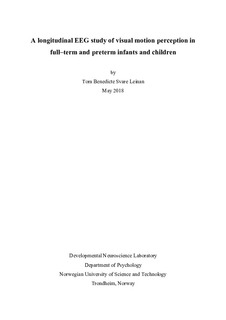| dc.description.abstract | High-density electroencephalogram (EEG) was used to longitudinally study evoked and induced brain electrical activity in full-term and preterm infants and children at 4-5 months, 11-12 months and at 6 years of age as a function of visual motion perception. The participants watched simulated structured forwards and reversed optic flow, as well as non-structured random visual motion. Analyses of visual evoked potentials (VEPs) and temporal spectral evolution (TSE) were performed on EEG data, recorded with a 128/256-channel sensor array. Motor functions were also investigated through Movement Assessment Battery for Children (M-ABC). VEP results revealed that at 11-12 months and at 6 years of age, the full-terms significantly increased their sensitivity with shorter latencies to optic flow and thus detected structured optic flow more efficiently than random visual motion. The TSE analyses revealed increased synchronized activity, especially in late alpha- and early beta-band, but also in some gamma-band frequencies, for the full-term participants with increasing age. However, the preterm participants followed a different development where they only showed increased sensitivity to optic flow at 6 years of age, but at that age, they were still not capable of detecting structured optic flow more efficiently than random visual motion. Frequency analyses revealed that the preterm participants showed less high-frequency synchronized activity in late alpha- and early beta-band ranges at 11-12 months and at 6 years of age compared to the full-terms, and most of them did not show any synchronized activity at all. M-ABC showed that most of the preterm children seemed to do well in perceptual-motor tasks related to the visual dorsal stream at 6 years of age. The study concluded that the observed progression in visual motion processing for the full-term participants during the first year of life to primary school age can be attributed to an increase in self-produced locomotor experience, and neural maturation. The results show that with age, full-terms rely more on structured optic flow and show a more adult-like specialization for motion, with fewer but more specialized neurons. The preterm participants’ delayed development of visual motion perception can be related to a dorsal stream vulnerability caused by premature birth. The poorer differentiation between radial motions suggests that they still have an immature or altered network for processing visual motion information by the age of 6 years. Because premature children do seem to have caught up on some but not all areas for visual motion perception by the time they started school, further studies will reveal whether the observed dorsal stream impairments are just a sign of developmental delay or will follow them through life. | nb_NO |
